- Seller: Richard C (Contact)
- Location: Shortsville, New York
- Mileage: 43,112 Shown
- Chassis #: 3602837
- Title Status: Clean
UPDATE – The seller has added photos of the underside and a video of the engine running!
If you are a fan of unique cars, the Renault 4CV could be one of the most unique vehicles ever to be mass-produced. With features like suicide front doors, a rear-mounted engine, and uniquely French styling, it’s hard not to find this little 4-door intriguing. With over a million built, you would think they are commonplace, but few have survived, making this example a rare find! It is said to run and drive but could use some cosmetic work. The seller has decided to offer it here as a Barn Finds Auction!
The development of the 4CV started in the early 1940s, but due to WWII, it didn’t go into production until 1947. It would stay in production until the introduction of the Dauphine, which killed the 4CV’s sales. The final examples rolled out of Renault’s Billancourt factory in 1961. A total of 1,105,543 were produced and sold across several continents. Between its monocoque construction and small 4-cylinder engine, the 4CV was lightweight, cheap to buy, and affordable to run. As a result, most were driven until they were either worn out or had rusted so badly they weren’t safe to drive.
Early examples were powered by a 747 cc engine, but by the time this one was built, the engine had grown to 760 cc and was rated at 21 horsepower. That’s not a ton of power, but with a curb weight of just 1,370 pounds, it was enough for a 60 mph top speed. The one has recently been treated to a tune-up and a new radiator, so it is ready to drive.
As with most budget-friendly cars from the era, this Renault’s interior is simple and functional. While Renault’s leadership claimed the 4CV wasn’t inspired by the VW Beetle, it’s hard not to see similarities between them. Like the Beetle, the 4CV came with front bucket seats, a simple metal dash, a flat floor, and minimal creature comforts. Of course, when you are building an affordable car, those things might just come naturally. The inclusion of rear doors makes the 4CV stand out from the VW, making access to the rear seats much easier and allowing for a more comfortable experience for rear passengers.
Also, unlike the Beetle, these cars are very common these days. It’s truly a unique little machine, and it would be fun zipping around town and taking it to events. As stated, it could use some cosmetic work, but the seller has already installed a new fuel tank, tires, tail lights, and door seals, so it’s off to a great start! If you’d love to be its next owner, cast your bids below, and be sure to leave any questions for the seller in the comment section.


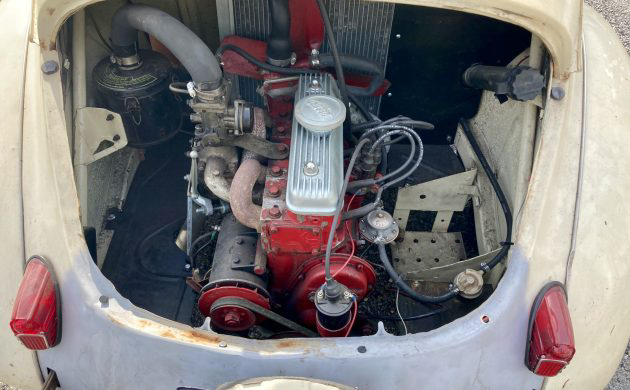
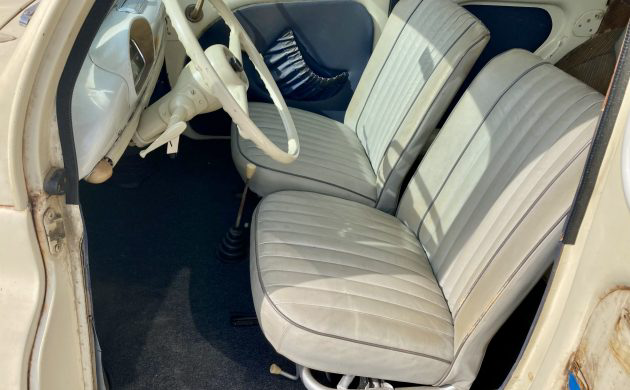

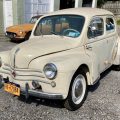
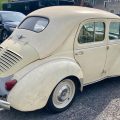


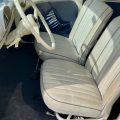
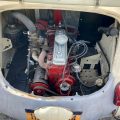
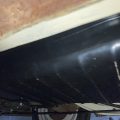
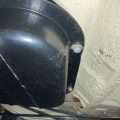
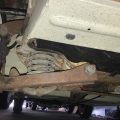



Instead of a Beetle, it reminds me of a Ford from the ’40s, only shrunken a bit. I bet it’s fun to drive, too.
Hard to tell from the low quality photos. Is that rotted out in front of the rear fenders?
You must be referring to the air intake.
No. That is surface rust the floor pans are all solid the bottom of vehicle is good with no rust holes
They’re air intake vents to cool the rear engine. These had a semi auto transmission which you operated with the stick but no clutch pedal.
Both of mine were 747cc (aka 750 models), 3 speed manuals.
Automatic was a much later option.
You’re thinking of the Ferlec electric clutch that was available as an option on some Renaults.
Lack of parts and service is what got
most of them. Everyone of my generation knew the French couldn’t
build and sell a reliable car if their lives depended on it. Same with the
British too. Only the Germans and the
Japanese got it right which is why they ruled the import market for so long. Forgot about the Italians though. With their cars you waited six months or longer to get the parts
you needed to fix it. That was because they didn’t have mass production facilities in Italy to produce anything but pasta. That’s
why my generation bought only American cars as they were well built
and reliable. And we all know that no two Fists were alike because they were mostly hand made. Might make
a great EV though.
Twat.
That’s all that can be said…
As you might suspect from my identity, your characterization, Kenneth, of Italian cars in general is far from reality. Yes, if you bought one back when importers, save for VW, were giving out dealerships like candy with no backup, probably some had problems with a Moretti, Alfa or other then-small makers. FIAT. tho’, had requirements for dealerships concerning training and parts. I bought the first of my many FIATs in 1958 and have never had service/parts problems.
True, FIAT has, over the years, made many boneheaded moves but that was simply the result of too-conservative leadership out of Torino. For example, the US advertising market is a world of difference from the more laid-back and sophisticated European advertising of the time. Sadly, edgy ads cooked up by the North American importers had to pass muster from FIAT S.p.A.’s offices on Park Avenue, NYC and that bunch, like any Caesar, loved to give the thumbs-down a lot. As a result, we were treated to lukewarm but Euro-sophisticated advertising which went right over most Yank’s heads.
Other Park Avenue dumb moves were in model selection. Example: starting in around 1969, FNA imported a nice but bland sedan, the 850. It came with 40HP. The Sport models had slightly warmed up mills with 50HP and front discs. Europe had 850 Specials which had Sport engines and discs plus nicer interiors and outside trim… for a 5% premium! ($1470 v. $1400) Could we get it? NO WAY! “Cheap is the way to go at the bottom of the market” saith Park Avenue.
The Special was a very desirable little car approaching the BMW 2002 in accommodations and performance for a fraction of the cost. I had to resort to building my own and it was worth it. Kept mine for better than 15 years and 170K miles. And it was still going strong when we parted with it. (Wish I hadn’t!)
FIAT’s latest boneheaded move was the current importation of straight EV 500s, just as the EV market is foundering. Even in the EU, only a little over 2,000 were sold last year. I hear there’s a crash program to make it a hybrid by the inclusion of an infernal congestion engine (ICE). The word’s gotten around that straight EVs are not all they were cracked up to be and I, for one, wholeheartedly agree.
Give me an infernal congestion engine complete with a catatonic converter anytime.
I have a 2012 Fiat 500c for 12 years now with no problems and was also hoping for a hybrid instead of a full EV with the new ones.
The later R10 and R16 were very reliable, and well built cars
and handsome cars too!
Yumpin’ Yiminey, gonna get an earful on this one,,
Okay then, I’m not made of stone, you know, the 1st pic not only shows my 1st car, the 4CV( that I never actually drove on the road, but a lot of “driveway” time”),,and right behind it, the yellow MGB some 10 years later. Whole another story, there.
I’m a bit foggy on how we actually got the Renault. The old man had a couple, a Dauphine and a Caravelle, that I remember, oh, the guy across the alley had a Dauphine also and we may have been getting parts, but in the back row of a dealer a bit north of Milwaukee, Milrace Motors, in Thiensville, who specialized in foreign cars, there was a white ’59 4CV, in about the same condition, but a stuck motor. I thought it was $25 bucks( in 1971), but may have been as much as $50. Either way, me and my brother had more than enough from cutting grandmas grass.
We got it home to my parents somehow, took the motor apart, we soaked the cylinders, that the liners popped out. Pounded them down with a baseball bat, new head gasket( from JC Whitney) and it ran! By brother painted it with an electric paint gun, that turned out pretty good, but it smoked profusely,, baseball bat to the liners? Ya’ think? We were just dumb kids, and my brother drove us around a bit. We found out pretty quick how inept it was to the neighbors Barracuda, and we sold it, again, somehow.
I’m a bit rusty, but I think the finned valve cover may indicated a more powerful motor, and the 4CV was one of Renaults most successful cars, worldwide. It was produced in a bunch of countries in the millions, mostly for taxi and police work. It may have looked similar to the bug, but had several advantages. 1st, and foremost, a real heater, 4 doors, a “conventional” motor, that seemed to have more power than a 36 hp Bug, but was never well received here. Well, I can say, I( and my brother) had one, at the very start of our automotive shenanigans. Great to see one again.
The most successful Renault of all was the 2CV.
We all make mistakes, Terrry, I thought I was wrong once, but was mistaken,,,the 2CV was a Citroen.
So right you are about the 2CV. There goes my 100% mistake-free record.
Always loved these and they were/are in the real Mille Miglia.It would be so cool to add some Gordini hop up parts and few French decals and take it on the Breakfast Club Rally runs put here in Sonoma.
There is currently a ratrod builder in Africa putting one of these bodies on a shortened VW Bug running gear as a build for his wife.
Even though he and his wife have accumulated some years each, and his reengineering skills are extensive, it’s going to be a gear shifter.
He works on it in tandem with his early Hudson on Nash Ute.
we named this typ “Chremeschnittchen” – cream slices
Yes, in Germany they are called “Cremeschnittchen”
The correct translation is “Napoleons”. I guess the front suggests layer cake…
We didn’t have much money when we were in high school, so when my dad found out there was a car in Jerico, Iowa (close to where we lived), we went and got it out of the brush and shrubs and brought it home. My dad could make anything run, and this one was no different. I drove it through many of my high school days.
Worst experience with it: getting dragged home in it 3 feet behind my brother’s 46Ford F150 at 70mph. Lesson: no matter how hard you press the break pedal, you can’t slow down a 46 Ford pick up with a 4CV.
BUT, it was cheap to run and the GIRLS all loved it…
“46 F150”? Rare indeed
And with the even rarer “break pedal”.
Thanks for catching that error…I am so used to bragging about my F150 that I put the wrong Ford in the note!
The pickup “tow” that scared me to death was a 46 Ford that my twin brother was driving…
Chain tow?
My Dad towed me on my motorcycle once…
I just held the rope.
It was scary.
The 4CVs had an impressive racing history in their day, victories at Rallye de Monte Carlo, Le Mans, Mille Miglia, Monthléry, etc., etc. It’s also worth noting that Alpine’s A106 was a souped-up 4CV with a streamlined fiberglass coupe body (also raced successfully)
This car looks quite good, but the leading edge of the driver’s door, and the front hood (trunk lid) don’t seem to fit right, leading me to suspect some past collision damage to the driver’s front fender area. That could be a minor challenge to rectify, but other than that, it could be a simple cosmetic restoration.
My wife of the 70’s bought one of these for almost nothing. It had been sitting with a bad starter and the seller couldn’t locate one.
She quickly learned to start it with the crank. She especially liked when macho men would see her get out the crank, try to start it for her and fail. Then she showed them how it was done. She wasn’t big and strong, just learned the technique.
She sold it when we thought t was too rusty to drive.
I thought it was 28 hp but it’s been gone for 50 years.
The engine was used in a few cars. The capacities were 600, 750 and 850cc,all had the same 80mm stroke with three bearing crank. A Gordini version was offered in the Dauphine. All parts can be interchanged. The engine was later fitted to a small tractor. A baseball bat should not be necessary for the wet liners as they are not press fit – they can be removed by hand or a slight tap with a soft mallet. Early liners used a copper ring on the bottom and later versions used a paper gasket. The R4 version swapped the water pump and generator around as it was a front drive car. These ancilliaries were driven through the 2:1 reduced drive camshaft then sped up again by the pulleys on the other end. This engine suffered additional wear on the rear main bearing from the extra load. The width of the bearings reduced from front to back hence the bearing with the least width carried the extra load. A later bearing improvement was to delete the oil groove in the lower load bearing half of the shell bearing. Early carburetors used a 16mm venturi and later versions used a big bore 20mm venturi.
Yes, Rat Rods for Africa! It’s my favorite YouTube channel. Diff who runs the shop is very talented and his videos are informative & funny. I have learned so much from watching his videos. His 4CV is slowly coming together but after seeing this car it gives me a better perspective on the model, they are very attractive.
These cars started as the “760” at 757cc (I think)
Shortly after introduction they were reduced to 747cc so that they could compete in the then current under 750cc class. They were quite successful in that class; and, yes, there were other competing marques!
They were a three speed manual, until the Ferlec automatic was introduced. There was a sporty version the R1063 (I think was the model designation), it was souped up hand had a 5 speed transmission. (Basis for the Alpine?)
The Dauphine (mid 50s) had the 850cc engine, 3 speed. Four speed transmission was in the Gordini.
Looks like a getaway car for a group of midget gangsters
I have several questions for the seller. I see no battery. Will you be including a battery? Do you have any photos of the undercarriage? Do you have some more photos of the interior like the back part and of the complete dash? Are the brakes in good shape or will I be changing out shoes and wheel cylinders right away? Is the engine running nicely?
….and one more question. Can you comment on the hood and driver door not fitting properly? Was it crunched at the fender and repaired?
As long as I’ve had the car there has been no front end damage the hood and the door are as they are I haven’t done anything to them more pictures are coming of the underside and there is a video of the engine running
… so I’m waiting for
I await the new photos of the undercarriage, front of dash and video of it running. Thank you.
In the late 1940s-early 50s, Renault exported a lot of these 760/750/4CVs to Germany!
When making your video of the engine and interior and inside the front hood if you show the battery it will tell us the voltage and the pedals will tell whether or not it has a clutch etc and this will help you sell the car for more money.
Yes it is manual shift with clutch pedal and it does have a battery
It is probably 6 volt.
If I recall correctly, the battery is in the engine compartment
That appears to beva battery holder in the right foreground of the engine photo. It is surrounded by the fuel line, the size would indicate six volt.
The finned rocker cover appears to be non-standard or may indicate something else.
Is it a three speed transmission?
Garry. I think you are correct about 6 volt. However it is not a problem as depending on the model and country of sale Renault changed to12 volt around 1965 to 1968. Everything can be swapped straight across including headlight bulbs.. I might even have a starter & generator here in Oz. The generator from R8 & R10 will fit by grinding a small lug off and spot welding it in another position. Electricals are either SEV or Ducellier or a mixture of both in the same vehicle.
this is a 12v system converted 12v battery
I waited 5 months for a fender for a 73′ Fiat 124 Sports Coupe and that was in 1974.Trunk latch broke,toggle switches failed and even the rubber hose to the gas tank rotted out.
Citroen’s 2CV outsold these cars and were built in much higher numbers over a longer period. They are extremely durable and dependable because they were designed from scratch with their own unique engine, not one adapted from another car. Air cooling was much simpler and lighter. Front drive worked better in bad weather. My ‘86 2CV is great fun to drive and a very “friendly” car, especially with the ladies!
Remember that the 2CV sold for over 40 years, the 4CV for about 14!
So the sales figures are hardly a comparison for quality or anything else.
The 4CV had a successful sporting career right from the start.
Rear engine Right wheel drive vs Front engine wrong wheel drive isn’t exactly apples to apples either.
Had one of these in 1964 at the age of 18.
Paid $35.00 cash and drove the fool out of it and myself. Had tons of fun popping wheelies if you kept pumping the gas it would catch some air you could clear a small coke bottle laying on its side. Oh the fun being young, dumb & full of something
My dad and I purchased this particular car around 2008 for a father son project. The car came from North Carolina and didn’t have an engine at the time. My dad met a guy at a car show who said he had an engine for sale.
I contacted the guy and he said his dad had a new Renault Dauphine that was totaled when almost new. His dad had removed the engine with 16,000 miles on it and saved it in their house. We installed the engine and the project kind of stalled. We sold the car to Rich and he got it over the finish line so it was running and driving. It is a cool little car with zero rust. It’s hard to find a 4CV that is as solid as this car. Good Luck with the Auction
for me as the high bidder a interesting story